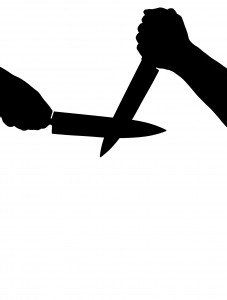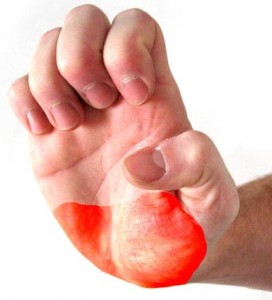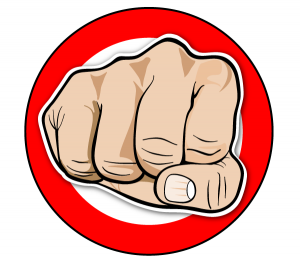In the near future, I will offer tips for writing fight scenes: how to keep the tension throughout the scene, how to create suspense leading up to the fight scene, how and when to stretch out time during the scene, and on the other side of that coin, how to speed up the beats in the scene.
Stay tuned.
Author Archives: janet.mcclintock@gmail.com
Action Scene – Knife Grip
Can the knife grip an attacker uses indicate his or her training level?
The short answer is: no. A blade is a blade, and it will spoil anyone’s day quickly, efficiently and lethally. It doesn’t matter in whose hands it finds itself—man or woman (or child), trained or untrained.
First, let’s define terms. There are two basic grips on a knife. In Kali they are called heaven grip and earth grip. Pick up a knife. If, when holding your arm straight to the front, the point of the blade points upward, that is heaven grip. If the knife is gripped so the blade exits the fist from the pinky side and points toward the floor, that is earth grip. Continue reading
Thoughts on the movie, “Lone Survivor” based on the true story of former Navy Seal, Marcus Luttrell
Although I would highly recommend seeing this movie, I’m not a movie critic. As I gain confidence in my writing, I am more thorough in critiquing the submissions of members of my critique group, but I would barely consider myself an expert on grammar, sentence structure, or plot. However, I am is an expert on action.
This movie starts at the end, my favorite type of beginning. In the last scene before going to the “Three Months Earlier” narrative, Marcus Luttrell’s character is flat lining. The movie then breaks to scenes from Navy SEAL training, camaraderie among the members of the various teams, a briefing, problems with communications and the operation. These were great “waiting for the other shoe to drop” type scenes, necessary to the story, but of course, being the action junkie that I am, the action was what I was there for. Continue reading
If Not the Fist, What? – Janet McClintock
 My last blog talked about the inherent weakness of the fist. So, if not a fist, what? The palm heel, that’s what. The palm heel is the area at the base of your palm. To find it put your arm out straight, bend your hand back as if you are going to push open a door. That’s it. That’s the palm heel position.
My last blog talked about the inherent weakness of the fist. So, if not a fist, what? The palm heel, that’s what. The palm heel is the area at the base of your palm. To find it put your arm out straight, bend your hand back as if you are going to push open a door. That’s it. That’s the palm heel position.
The palm heel is proof that God loves us and wants us to defend ourselves. It neatly fits under the chin. It fits into the temple. It fits into the soft tissue behind the ear, the indentation at the base of the skull, the eye socket, the area under the nose, and even the solar plexus. It’s effective as a kidney blow. And after an upper strike to the chin, the fingers are right there to rake the eyes, pull the hair or pull the ear (yes, the ear).
Punching With the Fist – Rarely a Good Thing – Janet McClintock
 Form a fist. Look at it. If you’re looking at the knuckles, you are looking at the weakest striking surface. They are unprotected by fat or muscle. They are small. They are vulnerable. The back of the fist is a stronger striking surface, but against a hard target like the human skull, there’s still the danger of fracturing the small bones of the hand. The lateral, or outside, edge of the fist (known as the hammer fist) is stronger, but against something like a skull, there’s still the danger of fracturing the small bones on the outside of the hand. The impact would hurt like heck, but you would retain use of some of your hand, if you’re lucky…and have dense bones.
Form a fist. Look at it. If you’re looking at the knuckles, you are looking at the weakest striking surface. They are unprotected by fat or muscle. They are small. They are vulnerable. The back of the fist is a stronger striking surface, but against a hard target like the human skull, there’s still the danger of fracturing the small bones of the hand. The lateral, or outside, edge of the fist (known as the hammer fist) is stronger, but against something like a skull, there’s still the danger of fracturing the small bones on the outside of the hand. The impact would hurt like heck, but you would retain use of some of your hand, if you’re lucky…and have dense bones.


